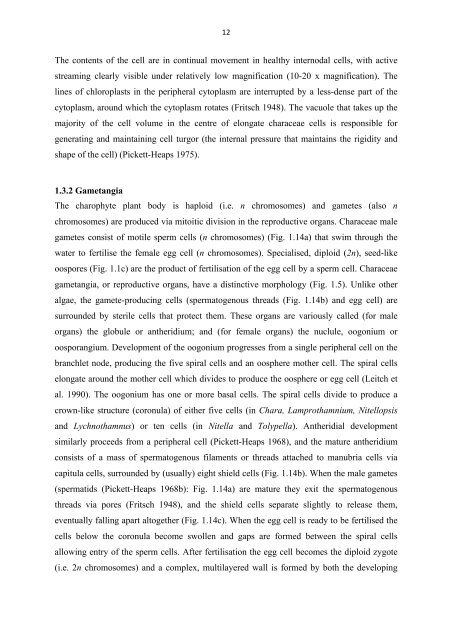Chapter 1: The Characeae Plant
Chapter 1: The Characeae Plant
Chapter 1: The Characeae Plant
Create successful ePaper yourself
Turn your PDF publications into a flip-book with our unique Google optimized e-Paper software.
12 <br />
<strong>The</strong> contents of the cell are in continual movement in healthy internodal cells, with active<br />
streaming clearly visible under relatively low magnification (10-20 x magnification). <strong>The</strong><br />
lines of chloroplasts in the peripheral cytoplasm are interrupted by a less-dense part of the<br />
cytoplasm, around which the cytoplasm rotates (Fritsch 1948). <strong>The</strong> vacuole that takes up the<br />
majority of the cell volume in the centre of elongate characeae cells is responsible for<br />
generating and maintaining cell turgor (the internal pressure that maintains the rigidity and<br />
shape of the cell) (Pickett-Heaps 1975).<br />
1.3.2 Gametangia<br />
<strong>The</strong> charophyte plant body is haploid (i.e. n chromosomes) and gametes (also n<br />
chromosomes) are produced via mitoitic division in the reproductive organs. <strong>Characeae</strong> male<br />
gametes consist of motile sperm cells (n chromosomes) (Fig. 1.14a) that swim through the<br />
water to fertilise the female egg cell (n chromosomes). Specialised, diploid (2n), seed-like<br />
oospores (Fig. 1.1c) are the product of fertilisation of the egg cell by a sperm cell. <strong>Characeae</strong><br />
gametangia, or reproductive organs, have a distinctive morphology (Fig. 1.5). Unlike other<br />
algae, the gamete-producing cells (spermatogenous threads (Fig. 1.14b) and egg cell) are<br />
surrounded by sterile cells that protect them. <strong>The</strong>se organs are variously called (for male<br />
organs) the globule or antheridium; and (for female organs) the nuclule, oogonium or<br />
oosporangium. Development of the oogonium progresses from a single peripheral cell on the<br />
branchlet node, producing the five spiral cells and an oosphere mother cell. <strong>The</strong> spiral cells<br />
elongate around the mother cell which divides to produce the oosphere or egg cell (Leitch et<br />
al. 1990). <strong>The</strong> oogonium has one or more basal cells. <strong>The</strong> spiral cells divide to produce a<br />
crown-like structure (coronula) of either five cells (in Chara, Lamprothamnium, Nitellopsis<br />
and Lychnothamnus) or ten cells (in Nitella and Tolypella). Antheridial development<br />
similarly proceeds from a peripheral cell (Pickett-Heaps 1968), and the mature antheridium<br />
consists of a mass of spermatogenous filaments or threads attached to manubria cells via<br />
capitula cells, surrounded by (usually) eight shield cells (Fig. 1.14b). When the male gametes<br />
(spermatids (Pickett-Heaps 1968b): Fig. 1.14a) are mature they exit the spermatogenous<br />
threads via pores (Fritsch 1948), and the shield cells separate slightly to release them,<br />
eventually falling apart altogether (Fig. 1.14c). When the egg cell is ready to be fertilised the<br />
cells below the coronula become swollen and gaps are formed between the spiral cells<br />
allowing entry of the sperm cells. After fertilisation the egg cell becomes the diploid zygote<br />
(i.e. 2n chromosomes) and a complex, multilayered wall is formed by both the developing
















